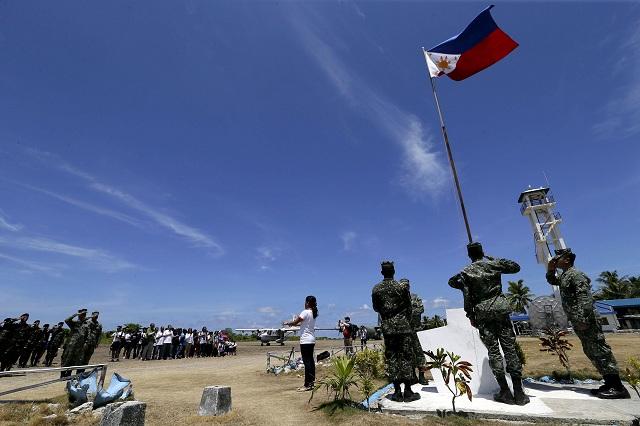
AFP chief Gen. Gregorio Pio Catapang Jr. visits Pagasa Island. (photo by Krisken Jones, InterAksyon.com)
Fewer than 48 kilometers away, China’s giant construction
cranes glint on the horizon, a sign of the Asian giant’s reef-building frenzy
in the disputed Spratly chain that has seen new islands appear seemingly
overnight.
As China and fellow rival claimant Vietnam race to pave over
reefs and build structures in the strategically important sea, the Philippines
stands out as a laggard.
The 356 residents of the remote Manila-held coral outcrop
they will soon be forced out by China
"Before we landed we saw the reclamation in the
(nearby) Subi Reef and it's really enormous," Catapang said on a tour of
the island's largely decrepit facilities. An old navy transport ship lay
half-submerged in waters off the coast, with two anti-aircraft guns the only
visible defenses.
The Spratlys, an archipelago of more than a hundred islands,
reefs and atolls between Vietnam
and the Philippines
The United States
last week sounded the alarm, accusing China
Alarmed at the Chinese activity, other Spratlys claimants
have not been idle. Vietnam
is reported to be reclaiming land in two areas, while Taiwan and Malaysia
The Philippines
'Without firing a shot'
Life is usually uneventful for the inhabitants of Pagasa,
the largest Philippine-occupied island which lies 433 kilometers from Palawan , and receives electricity just five hours a day.
They include soldiers, coastguard personnel and
military-employed civilians, many of whom bring their wives and children with
them to stave off loneliness.
But the Philippine army says that since last month Chinese
vessels off the Subi reef have warned Filipino air force planes flying in and
out of Pagasa to leave, saying they are violating its military airspace.
"This is bad for us who live here. We depend on the
planes to deliver our food," one concerned municipal employee, 37-year-old
Larry Jugo, told Agence France-Presse.
Rear Admiral Alexander Lopez, commander of the Western
Command, to which forces in the South China Sea
belong, said the action was effectively an enforcement of an undeclared air
defense identification zone.
"They build these things, they say for legal reasons,
but for military purposes as necessary. That's very alarming," he said.
Elsewhere in the Spratlys, Lopez said China
Authorities and regional analysts see it as a powerful
campaign aimed at making it impossible for the Philippines
"As far as I know, there is not much that the Philippines
"I think China
'We have nowhere to run'
Outgunned by China 's
military might, the Philippines ’
strongest card has been a suit to a United Nations tribunal, asking it to rule
that China
A verdict is expected next year, but Beijing
Analysts say China is unlikely to deliberately fire at
Filipino vessels, wary the Philippines could ask the United States to retaliate
by invoking the 1951 Mutual Defense Treaty, and also reluctant to be seen as a
regional aggressor.
Nonetheless, the Philippines has sought to upgrade its
capabilities by acquiring two second-hand US patrol craft and ordering fighter
jets from South Korea that would allow it to maneuver more swiftly over the
contested waters.
But its efforts to draw in the United States
With the Philippines
becoming increasingly vulnerable, Pagasa islander Jugo plans to send his wife
and two children home to Palawan next year
just in case trouble erupts.
"We have nowhere to run ... we will be forced to fight
whatever happens," he said.
http://www.interaksyon.com/article/110465/focus--china-gains-territory-without-firing-a-single-shot---and-the-philippines-can-only-watch


